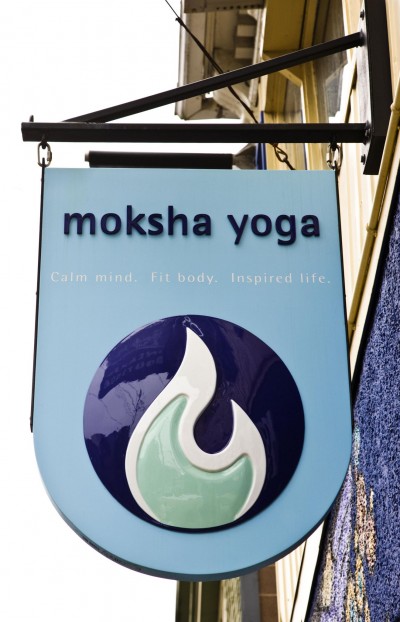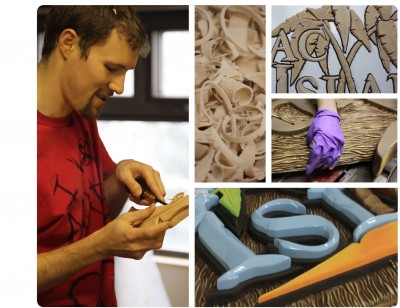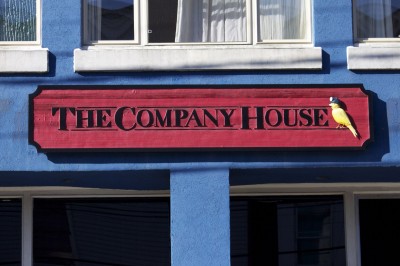Revitalizing urban streetscapes
by Matthew | 10 September 2012 8:30 am
 [1]
[1]Photos courtesy Eyecandy Signs
By Allison Moz
In many downtown districts across Canada, revitalization efforts are being initiated to help rebuild prosperous and profitable city cores. As consumers’ spending habits have evolved beyond downtown over the years, to include shopping in suburban malls and buying goods online, many owners of downtown businesses have had to think creatively about how to protect—and further develop—their economic viability. This trend has spawned new partnerships between local business associations, municipal governments, urban designers and other creative professionals, such as signmakers, who are working together to envision and fulfil the potential of these urban environments.
The role for signmakers is momentous. Signage has a unique ability to bridge the gap between the technical functions of urban design and the cultural esthetics of a streetscape. Traditional signmakers are creative and skilful at articulating the quality and tone of an individual brand, understanding the subtleties of character and knowing what to understate and what to embellish.
Indeed, the old craft is experiencing a rebirth in today’s digital age. Everyday urban environments need to cultivate genuine emotional connections with the public to remain relevant. The ability to create a compelling environment, distinguish a brand and tell a story is the highest value of traditional signage.
Pierre Tardif, a sign painter based in Val-Belair, Que., is exemplary of this renaissance. By evoking a nostalgic spirit for the 1950s, his hand-painted sign lettering does not merely announce the name of a business, but also fosters social affinity for that business.
“People really love the classic, vintage lettering,” he says. “It wakes up something inside them.”
Sign designers need to bring both an attentive eye and an attitude of confidence to draw inspiration from the passion and pride of a specific community. Every sign should be as unique as a fingerprint.
 [2]
[2]Traditional signmaking techniques are experiencing a rebirth in the digital age.
Beyond being attractive or sturdy, a sign for a local business needs to first draw attention and then communicate a message and convey a feeling about the community and its culture. Signs that communicate in this way are designed and built with creativity and technical expertise, but also with an understanding of purpose and opportunity.
Authentic and sensitive
Achieving these aims with a single sign requires a focused and dynamic approach. Enthusiastic, driven and skilful sign designers, sculptors and painters can work together, contributing their strengths to each project. Clients need to be able to trust them with the responsibility of reflecting their identity and that of their community. To this end, a sign shop’s portfolio of high-quality projects will help establish authenticity and sensitivity to each client.
Further, today’s clients are increasingly becoming shareholders in the design process. Whereas 25 years ago, everything was done by hand and a client’s rough concept would be entrusted to a signmaker to design fully, today the client is likely to bring in detailed data on a Universal Serial Bus (USB) flash drive.
 [3]So, traditional signmakers have to cautiously navigate a path between the client’s brand and the sign shop’s craftsmanship. It is important to understand the customer’s expectations, but there is also the opportunity through conversation to help clients appreciate the artisan’s approach and the labour-intensive process of building a customized sign by hand.
[3]So, traditional signmakers have to cautiously navigate a path between the client’s brand and the sign shop’s craftsmanship. It is important to understand the customer’s expectations, but there is also the opportunity through conversation to help clients appreciate the artisan’s approach and the labour-intensive process of building a customized sign by hand.
“Knowledge can breed passion,” says Jake Ethridge, owner of Eyecandy Signs in Halifax.
Within an urban revitalization effort, especially, pride in purpose helps give all partners a sense of ownership. Together, they can nurture signage that is locally focused and maximizes the significant qualities of each business.
Through a combination of vision, knowledge and technology, sign shops can deliver products that are both consistent and unique. They will be inspired to give their best.
Drawing connections
As the early 20th-century German-American architect Ludwig Mies van der Rohe put it, “God is in the details.” Subtleties help unique signs take form.
Indeed, connections can be drawn between the craft of signmaking and the greater world of art and architecture. In all of these fields, professionals are constantly refining their processes, customizing their tools and gaining better control over their techniques.
 [4]
[4]Designers, sculptors and painters contribute different strengths to the same sign project.
When it comes to sign painting, for example, specialized shops mix and blend their paints in-house, relying on formulas and software to ensure colour consistency. These systems allow the quick production of accurately colour-matched coatings.
Nevertheless, the true colour authority is the sign painter, whose sharp eye and understanding of the intricacies of colour theory can improve upon standard calculations and formulas.
“When complementary colours are combined in just the right composition to capture and articulate a sign’s ‘mood,’ they create a unique symphony of light and contrast,” says Ethridge. “Unexpected hues and tonal values can generate a quality that otherwise would not exist.”
A similar union between computer numerical control (CNC) routers and sculptors’ hands can also breathe life into dimensional signs, blending precision with depth of character. Many traditional sign shops are already benefiting from the speed and accuracy of CNC machines when shaping contours and carving broad strokes. The artisan remains the master, however, as traditional sculptors step up after CNC tool bit passes to embellish and refine the work with modelling clay and a chisel. Only an adept signmaker can animate the subtle qualities of a sign’s highlights and shadows.
By being bold and experimental, with a willingness to take risks, sign artists can grow their talents and elevate the potential of their work. Sometimes they will fail, but with humility they will learn from their mistakes, rather than try to hide from them. The experience can instill excitement and courage in them as they go on to develop new projects.
 [5]
[5]Dimensional details can help bring an otherwise flat sign to life.
Working together
Creating personal connections and enduring relationships through thoughtful design, careful execution and attention to detail will enable traditional sign shops to remain relevant in the digital age. They can work together with municipalities and fellow creative designers to revitalize Canada’s urban landscapes, adorning them with signs that celebrate a vibrant sense of place, honour the warmth of their communities and beautify their streetscapes.
Allison Moz is design principal for Halifax-based Eyecandy Signs. For more information, visit www.eyecandysigns.ca[6].
- [Image]: http://www.signmedia.ca/wp-content/uploads/2014/02/moksha_yoga.jpg
- [Image]: http://www.signmedia.ca/wp-content/uploads/2014/02/AirMaintenance.jpg
- [Image]: http://www.signmedia.ca/wp-content/uploads/2014/02/Hamachi-Steakhouse.jpg
- [Image]: http://www.signmedia.ca/wp-content/uploads/2014/02/MacIsland-Cafe.jpg
- [Image]: http://www.signmedia.ca/wp-content/uploads/2014/02/CompanyHouse.jpg
- www.eyecandysigns.ca: http://www.eyecandysigns.ca
Source URL: https://www.signmedia.ca/revitalizing-urban-streetscapes/